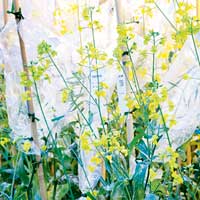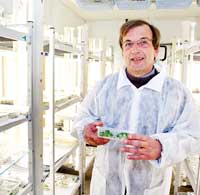VIDEO: Low-biomass OSR proves popular

The trend for breeding low biomass hybrid oilseed rape varieties appears to be gathering speed, as James Andrews discovered on a recent trip to Monsanto’s Boissay breeding station in France.
Excellent disease resistance is the latest farmer-friendly trait to be added as low biomass oilseed rape varieties continue to improve. Growers have found the reduced bulk of low biomass conventional varieties such as Castille and ES Astrid are much quicker and more efficient to harvest, and their shorter, stiffer straw reduces lodging risk.
These characteristics have been transferred to low biomass hybrid varieties, sometimes known as semi-dwarfs, by breeders including Monsanto, which markets it’s oilseed rape varieties under the Dekalb brand.
 The firm’s breeding strategy focuses on bringing hybrid varieties with medium to low biomass to the market, says oilseed rape breeding director Jean-Pierre Despeghel (right). “We aim to produce lower biomass crops with consistent yields, low lodging and pod shatter risk, and good resistance to stem canker, verticillium wilt and light leaf spot.”
The firm’s breeding strategy focuses on bringing hybrid varieties with medium to low biomass to the market, says oilseed rape breeding director Jean-Pierre Despeghel (right). “We aim to produce lower biomass crops with consistent yields, low lodging and pod shatter risk, and good resistance to stem canker, verticillium wilt and light leaf spot.”
Oil content is also top of the agenda along with protein content and balancing glucosinolate levels, he says. “But there needs to be a bit of a compromise between these traits,” he admits.
For example, glucosinolates are needed to keep the yield potential high and prevent pigeon and slug damage. But crushers are starting to demand varieties with lower glucosinolate levels as livestock find them more palatable. “This is a tricky balance as low glucosinolates are not desirable for growing the crop, especially when there is increasing pressure to reduce chemical inputs.”
Reduced pod shatter is an added benefit of our hybrids, he says. “We’ve had hard conditions during the past few harvests, with high levels of rainfall and strong winds, but these varieties have shown very good resilience.”
Dekalb’s DK Expower is currently in National List 2 trials with a gross output of 105. It has already been registered in Denmark earlier this year and has similar traits to Excalibur, although yield potential and oil content is higher.
But it is the exceptional disease resistance of the variety, which could excite growers. “It’s the first variety to have such a high combination of stem canker and light leaf spot resistance which should be difficult to break,” Mr Despeghel says. “It’s stem canker rating is 9 and light leaf spot is 8.” This means many growers will be able to use cheaper fungicide products or drop to a single spray programme. “In France, this won’t receive any stem canker sprays.”
DK Sequoia, a second new variety from Dekalb, comes from the same breeding station, but has shorter straw making it similar in height to Castille. It flowers late, but the flowering period is shorter than conventional varieties, meaning maturity is the same. It’s currently in HGCA RL trials for 2010 harvest and according to Dekalb it is capable of out-yielding Excalibur with a gross output of 103.8. Stem canker and light leaf spot resistance are lower than Expower at six and seven, respectively.
Its more prostrate growth habit will require a significant change in management strategy, even though the rate of development is similar, Mr Despeghel admits. “When more conventional varieties are flowering it looks short and backward. However, it catches up rapidly once it starts to flower a week later and matures at the same time.” The shorter flowering period means timing spray applications is more straightforward and shorter straw means high-clearance machines are not required, he notes.
Seed for both varieties will be available in limited quantities from the end of July and the firm anticipates a further four medium to low biomass hybrid varieties will be coming to the market in 2011.
Learning to manage low biomass oilseed rape
Low biomass oilseed rape develops differently to conventional long straw varieties and requires a significant change in management strategy, says Masstock‘s Philip Marr.
“The low biomass hybrid growth habit takes some getting used to and we’re only just starting to understand how to manage these crops effectively.”
As the crop is late-flowering, it looks under-developed until it takes off in May, he says. “While conventional varieties are growing away, they look short and backward, but once they start flowering in early May, they soon catch up.”
But low biomass hybrids have considerable potential, he says. “Flowering takes just three weeks and as all branches flower simultaneously you can get all the sclerotinia protection you need from a single spray in the first week of flowering.”
Unlike conventional low biomass varieties the new semi-dwarf hybrids grow to a capped, manageable height similar to Castille, he says. “They will never grow any higher, even under the best growing conditions.”
This means growers can sow from early August into ground that has had farmyard manure applied and it won’t grow to an unmanageable height. “Inputs can be applied precisely when they are needed and you can save some of your nitrogen for a late boost without worrying about crop damage.”
Growers on nitrogen rich soils such as black peats can also plant without fear of lodging, he says.
DK Expower Early maturing Restored hybrid Minimal lodging Gross Output: 104 Stem canker resistance: 9 Light leaf spot resistance: 8 Short and stiff stemmed Good lodging resistance | DK Sequoia No lodging Restored hybrid Gross Output: 103.8 Stem canker resistance: 6 Light leaf spot resistance: 7 Very short stiff stems Very good lodging resistance
|

